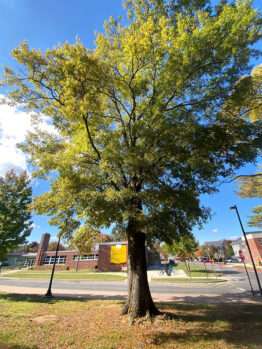Willow Oak
Researched by Valerie Vischoric
 Species: Quercus phellos
Species: Quercus phellos
Common name: Willow Oak
Family: Fagaceae (Beech Family)
Clade: Angiosperms (non-flowering seed plants)
Coordinates: 39.70825486, -75.12101821
A tag using this number is placed near the tree.
The first written observation of the willow oak was in 1723, and wood from these trees was used for pulpits, pews, bar tops, wagon axles, and much more. Willow oaks are native to the Southeastern and eastern United States and thrive in woods bordering swamps, streams, and canals. Due to their fast-growing nature and large canopies, willow oaks are commonly planted as shade trees. Willow oaks can grow up to 75 feet tall and 50 feet wide. They tolerate urban pollution and can survive in any type of soil, including clay. These trees also have a long lifespan, sometimes over 100 years. The leaves will turn green to yellow and then orange throughout the fall before dropping.
Willow oaks become mature and start producing reproductive structures after 15-20 years of age. As angiosperms, they produce flowers and bear their seeds in fruits. Willow oaks are monoecious, containing male and female reproductive structures on the same tree. The male flowers, catkins, are yellow and grow in droopy clusters that begin to bloom in late spring. This same type of inflorescence, or flower cluster, can be found on other oaks. Read More
Campus Species Map
Researcher’s Biography
 Valerie Vischoric
Valerie Vischoric
Valerie Vischoric earned a Bachelor of Science in Biological Sciences in 2023.
Suggested Citation:
Vischoric, Valerie. (2022, Dec). Willow Oak. Rowan University Arboretum. https://arboretum.rowan.edu/trees/willow-oak/
Questions to Explore
- What does the Latin name Quercus phellos mean, and why was this name used for this tree?
- When was the first scientific observation of the Willow Oak?
- What uses did the Willow Oak wood serve in the pioneering days?
References
Britannica, T. Editors of Encyclopaedia (2021, April 15). willow oak. Encyclopedia Britannica. | Link
Carter, C. (2020, April 22). Why does water soak upwards against gravity? BBC Science Focus Magazine. | Link
How do large trees, such as redwoods, get water from their roots to the leaves? (1999, February 8). Scientific American. | Link
Plant database. Lady Bird Johnson Wildflower Center – The University of Texas at Austin. (n.d.). | Link
Quercus phellos. Quercus phellos (Oaks, Willow Oak) | North Carolina Extension Gardener Plant Toolbox. (n.d.). | Link
Schaefer, L. (2020, October 2). Species spotlight – willow oak. Edge Of The Woods Native Plant Nursery, LLC. | Link
Rowan University Resources
You may need to log into the Rowan University Library website.
Biological Responses of Red Oaks and Willow Oak to Hypoxia in the Rhizosphere | Link
Seasonal physiology and growth of planted oasks with implications for bottomland harwood restoration | Link
Risk of bird predation and defoliating insect abundance are greater in urban forest fragments than street trees | Link











